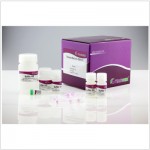Product Category:
Human Adenovirus Type5 (dE1/E3) expressing HMGB1.
Description:
High-mobility Group Box 1, pre-made adenovirus, ready to ship and ready to use format.
Gene Name:
High-mobility Group Box 1
ACCN:
NM_002128
Gene ID:
3146
GI Number:
4504424
Fusion Tag:
C-terminus 6xHN tag
Promoter:
CMV
Titer:
1x1010~1x1011 PFU/ml
Storage Buffer:
DMEM with 2.5% BSA, 2.5% glycerol
Background:
HMGB1 (High-mobility group box-1) protein was originally described as a nuclear non-histone DNA binding chromosomal protein. However, recent studies indicate that damaged, necrotic cells liberate HMGB1 into the extracellular milieu where it functions as a proinflammatory cytokine. Mouse HMGB1 is expressed as a 215 amino acid single chain polypeptide containing three domains: two tandem-linked positively charged DNA-binding domains (HMG box A, aa 9-79; and box B, aa 89-162), and a negatively charged 30 aa C-terminal acidic tail region. Residues 28 - 44 and 180 - 185 contain a nuclear localization signal (NLS). The cytokine activity of HMGB1 is contained in the B box, while the A box is associated with the helix-loop-helix domain of transcription factors. HMGB1 acts both as an inflammatory mediator that promotes monocyte migration and cytokine secretion, as well as a mediator of T cell-dendritic cell interaction. HMGB1 is secreted and acts to transduce cellular signals through its high affinity receptor, RAGE and possibly, TLR2 and TLR4. HMGB1 is highly conserved and ubiquitous in the nuclei and cytoplasm of nearly all cell types, is a necessary and sufficient mediator of inflammation during sterile and infection-associated responses. HMGB1 also act as DNA nuclear binding protein that has recently been shown to be an early trigger of sterile inflammation in animal models of trauma-hemorrhage via the activation of the Toll-like receptor 4 (TLR4) and the receptor for the advanced glycation endproducts (RAGE). Moreover, HMGB1 is reported that the level of HMGB1 is elevated during sterile tissue injury, infection, lethal endotoxemia or sepsis, collagen-induced arthritis, and ischemia-reperfusion induced tissue injury.
Documents:

